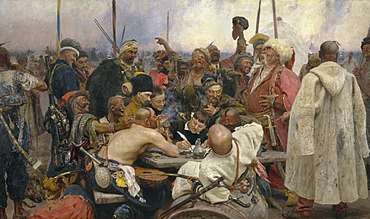Bashlyk
A bashlyk, also spelled bashlik (Karachay-Balkar: Başlıq, Adyghe: Shkharkhon, Abkhaz: qtarpá, Crimean Tatar: Başlıq, Tatar: Başlıq, Turkish: Başlık; "baş" - head, "-lıq" (Tatar) / "-lık" (Turkish) - derivative suffix), is a traditional Turkic, Caucasian, Iranian, and Cossack cone-shaped headdress hood, usually of leather, felt or wool, an ancient round topped felt bonnet with lappets for wrapping around the neck. Local versions determine the trim, which may consist of decorative cords, embroidery. metallized strings, fur balls or tassels. Among dozens of versions are winter bashlyks worn atop regular headdress, cotton bashlyks, homeknitted bashlyks, silk bashlyks, scarf bashlyks, down bashlyks, dress bashlyks, jumpsuit-type bashlyks, etc. Bashlyks are used as traditional folk garment, and as uniform headdress.[2][3]
A variation of bashlyks is a Kalpak (Qalpaq), a cone-shaped headdress without lappets, mostly made of leather, felt or wool,[4] as depicted in the Repin's painting below. "Kalpak" is also a component of the ethnic name "Kara-Kalpak" (literally "a black kalpak" in Turkic), known from the history of the medieval Eastern Europe, and from the modern Karakalpak autonomous republic in the western Syr Darya - Amu Darya interfluve in Uzbekistan, north of the ancient Balkh.
In modern times, bashlyks became fashionable in Russia in 1830-1840, after the Napoleonic War with significant participation of the Bashkir cavalry. By the 1862 bashlyks were made a uniform headdress in Cossack armies, and later in other branches of Russian armed forces. The military bashlyk was bright yellow camel wool, with a yellow band. Officer bashlyks had gold or silver band. In Russian army bashlyks lasted till 1917, when they became a trademark of White Army uniform,[5] and some White Army troops have the lappets tucked into the belt on the front instead of wrapping around the neck.
Gallery
 4 18th century Cossack bashlyks, 2 with fur trim, 1 officer's, 1 with fur coat. "Reply of the Zaporozhian Cossacks".
4 18th century Cossack bashlyks, 2 with fur trim, 1 officer's, 1 with fur coat. "Reply of the Zaporozhian Cossacks".
See also
References
- Keen, Antony G. (1998). Dynastic Lycia: A Political of History of the Lycians and Their Relations with Foreign Powers : C. 545-362 B.C. BRILL. p. 153. ISBN 9004109560.
- Hat Dictionary
- Значение и этимология слов на букву Б Archived April 21, 2007, at the Wayback Machine
- kalpak - Definition from the Merriam-Webster Online Dictionary
- "Русский Военный Мундир Xviii-Xix Веков". Archived from the original on 2007-03-12. Retrieved 2007-02-11.
